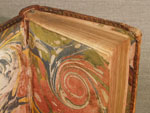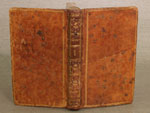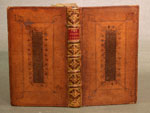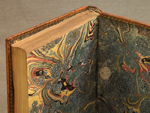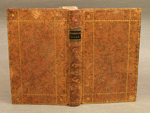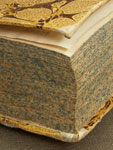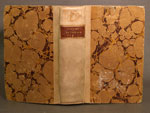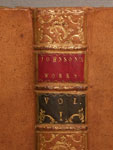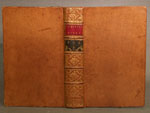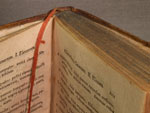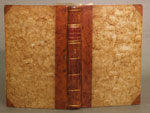18th Century: Elaboration and Simplicity
Binders began to make shortcuts in the binding process to both save money and increase production. Sewing is now on recessed cords to give the spine a smooth appearance (increasing the type of decoration which could be used). Half and quarter bindings (combining leather with decorated paper sides) are used to save the cost of leather. Overall, binding decoration becomes fancier, while the structure of the book becomes simpler.
- Author:
- Ralph, James, d. 1762.
- Title:
- The touch-stone: or, Historical, critical, political, philosophical, and theological essays on the reigning diversions of the town ... In which everything antique, or modern, relating to musick, poetry, dancing, pantomimes, chorusses, cat-calls ... circus, bear-garden, gladiators, prize-fighters ... is occasionally handled. By a person of some taste and some quality. With a preface, giving an account of the author and the work.
- Publisher:
- London, 1728.
- Call Number:
- PN 2036 .R3
Full leather binding with a panel design, also called a Cambridge panel. Other characteristics show this is an early 18th century binding: edges sprinkled in red, red labels on spine and the red and yellow handsewn endbands.
- Author:
- Shakespeare, William, 1564-1616.
- Title:
- Poems written by Shakespeare.
- Publisher:
- London, J. Bell & C. Etherington, 1774.
- Call Number:
- 38-PR2841 .A1 1774.jpg
This full leather has a geometric pattern gold tooled on covers with gold tooled ornaments on the spine. The black title label may have been added later. As is typical with many 18th century bindings, the endbands are three color, double handsewn. The edges are dyed yellow, also typical of this century.
- Author:
- Linné, Carl von, 1707-1778.
- Title:
- Caroli Linnæi Fundamentorum botanicorum ... pars prima[-secunda]
- Publisher:
- Coloniæ-Allobrogum, sumptibus Piestre & Delamolliere, 1786-1787.
- Call Number:
- QK 91 .F9 1786
An example of the quarter bound style, with vellum spine and marbled sides. The vellum corners were meant to protect them from damage. To save money, binders started to use marbled or decorated paper sides during the 17th century. Again, another example of the sprinkled edge.
- Author:
- Johnson, Samuel, 1709-1784.
- Title:
- The works of Samuel Johnson, LL. D. : together with his life, and notes on his Lives of the poets / by Sir John Hawkins, Knt. : in eleven volumes.
- Publisher:
- London : Printed for J. Buckland [and 40 others] ..., 1787.
- Call Number:
- PR 3520 .D87 v.1 1787
Full leather binding. The leather is decorared in the “sprinkle” style, a process similar to tree calfing (see early 19th century). Other typical 17th century characteristics include: red, white and blue double handsewn endbands and red dyed edges on the textblock.
- Author:
- Fabricius, Johann Christian, 1745-1808.
- Title:
- Ioh. Christ. Fabricii ... Mantissa insectorum : sistens eorum species nuper detectas, adiectis characteribus genericis, differentiis specificis, emendationibus, observationibus.
- Publisher:
- Hafniae : C. G. Proft, 1787.
- Call Number:
- QL 463 .F334 1787 v.1
Half binding with leather spine and pastepaper sides. Simple gold tooling and red label on spine indicate this was the 17th century equivalent of a “budget” binding. The endbands are handsewn, the edges are sprinkled blue and there is a ribbon bookmarker adhered to the spine.
- Author:
- Du Laurens, Henri Joseph, 1719-1797.
- Title:
- Imirce, ou La fille de la nature.
- Publisher:
- Londres, 1782.
- Call Number:
- PQ 1981 .D75 I5 t.1+2
Full leather binding again using the “sprinkle” style. Gold tooling on spine, covers and squares. Edges are gilded and endpapers are marbled.
